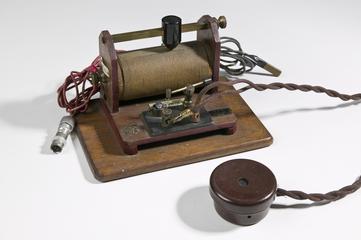
Marconi magnetic wireless detector
- Made:
- 1903-1907 in Chelmsford

Marconi magnetic wireless detector, serial number 763, together with glass-topped cover. Early serial number dates this object to between 1903 when the Marconi Company began to make the magnetic detector and 1907 when a magnetic detector with a later serial number held by the Museum of the History of Science, Oxford is dated.
The Magnetic Detector was one of the first practical devices able to make radio signals audible through a pair of earphones. Marconi's Magnetic Detector was first patented in 1902; it was an important advance and more sensitive than the coherer. It was the standard form of detector for the reception of spark telegraphic signals between 1903 and 1918 in both ship and shore installations until it was gradually superseded by the crystal and later by the valve.
The magnetic detector consisted of a soft-iron band, moving by clockwork at a uniform rate of 8 centimetres per second, through a tube and past permanent magnets. The tube carried a primary winding connected to the aerial circuit and a secondary winding connected to the headphones. When a signal was received from a spark transmitter in the primary winding, this affected the magnetism which was induced in the iron band as it entered the tube. This variation of magnetism induced a current in the secondary winding and hence clicks were heard in the headphones.
Details
- Category:
- Radio Communication
- Object Number:
- 1939-26
- type:
- wireless detector
- credit:
- Royal Military College




